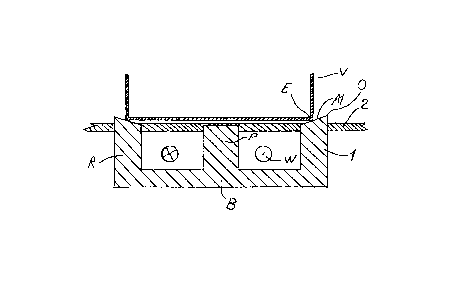Une partie des informations de ce site Web a été fournie par des sources externes. Le gouvernement du Canada n'assume aucune responsabilité concernant la précision, l'actualité ou la fiabilité des informations fournies par les sources externes. Les utilisateurs qui désirent employer cette information devraient consulter directement la source des informations. Le contenu fourni par les sources externes n'est pas assujetti aux exigences sur les langues officielles, la protection des renseignements personnels et l'accessibilité.
L'apparition de différences dans le texte et l'image des Revendications et de l'Abrégé dépend du moment auquel le document est publié. Les textes des Revendications et de l'Abrégé sont affichés :
| (12) Demande de brevet: | (11) CA 2283125 |
|---|---|
| (54) Titre français: | STRUCTURE DE NOYAU POUR ELEMENT DE CHAUFFAGE PAR INDUCTION |
| (54) Titre anglais: | A CORE STRUCTURE FOR AN INDUCTION HEATING ELEMENT |
| Statut: | Réputée abandonnée et au-delà du délai pour le rétablissement - en attente de la réponse à l’avis de communication rejetée |
| (51) Classification internationale des brevets (CIB): |
|
|---|---|
| (72) Inventeurs : |
|
| (73) Titulaires : |
|
| (71) Demandeurs : |
|
| (74) Agent: | SMART & BIGGAR LP |
| (74) Co-agent: | |
| (45) Délivré: | |
| (86) Date de dépôt PCT: | 1998-03-13 |
| (87) Mise à la disponibilité du public: | 1998-09-17 |
| Licence disponible: | S.O. |
| Cédé au domaine public: | S.O. |
| (25) Langue des documents déposés: | Anglais |
| Traité de coopération en matière de brevets (PCT): | Oui |
|---|---|
| (86) Numéro de la demande PCT: | PCT/DK1998/000096 |
| (87) Numéro de publication internationale PCT: | WO 1998041061 |
| (85) Entrée nationale: | 1999-09-01 |
| (30) Données de priorité de la demande: | ||||||
|---|---|---|---|---|---|---|
|
Un noyau de forme évasée destiné à un appareil de chauffage par induction comprend des parties de couronne présentant une grande surface jusqu'au bord du récipient de cuisson. Ces parties de couronne sont obtenues au moyen d'une découpe oblique de la couronne ou par découpe oblique de la couronne elle-même vers l'intérieur. Le flux de fuite est réduit du fait que le bord du récipient de cuisson fait office d'"attracteur" pour les lignes de flux émanant du noyau.
A dish-shaped core for an induction heating apparatus is provided with rim
parts which present a large area to the edge of the cooking vessel. These rim
parts are obtained by means of a slanted cut of the rim or by slanting the rim
itself inwards. The leakage flux is reduced because the edge of the cooking
vessel acts as an "attractor" for the flux lines emanating from the core.
Note : Les revendications sont présentées dans la langue officielle dans laquelle elles ont été soumises.
Note : Les descriptions sont présentées dans la langue officielle dans laquelle elles ont été soumises.

2024-08-01 : Dans le cadre de la transition vers les Brevets de nouvelle génération (BNG), la base de données sur les brevets canadiens (BDBC) contient désormais un Historique d'événement plus détaillé, qui reproduit le Journal des événements de notre nouvelle solution interne.
Veuillez noter que les événements débutant par « Inactive : » se réfèrent à des événements qui ne sont plus utilisés dans notre nouvelle solution interne.
Pour une meilleure compréhension de l'état de la demande ou brevet qui figure sur cette page, la rubrique Mise en garde , et les descriptions de Brevet , Historique d'événement , Taxes périodiques et Historique des paiements devraient être consultées.
| Description | Date |
|---|---|
| Le délai pour l'annulation est expiré | 2004-03-15 |
| Demande non rétablie avant l'échéance | 2004-03-15 |
| Inactive : Abandon.-RE+surtaxe impayées-Corr envoyée | 2003-03-13 |
| Réputée abandonnée - omission de répondre à un avis sur les taxes pour le maintien en état | 2003-03-13 |
| Lettre envoyée | 2001-03-23 |
| Exigences de rétablissement - réputé conforme pour tous les motifs d'abandon | 2001-03-15 |
| Réputée abandonnée - omission de répondre à un avis sur les taxes pour le maintien en état | 2001-03-13 |
| Lettre envoyée | 2000-02-25 |
| Inactive : Transfert individuel | 2000-01-28 |
| Inactive : Page couverture publiée | 1999-11-05 |
| Inactive : CIB en 1re position | 1999-10-29 |
| Inactive : Lettre de courtoisie - Preuve | 1999-10-19 |
| Inactive : Notice - Entrée phase nat. - Pas de RE | 1999-10-13 |
| Demande reçue - PCT | 1999-10-08 |
| Demande publiée (accessible au public) | 1998-09-17 |
| Date d'abandonnement | Raison | Date de rétablissement |
|---|---|---|
| 2003-03-13 | ||
| 2001-03-13 |
Le dernier paiement a été reçu le 2002-03-13
Avis : Si le paiement en totalité n'a pas été reçu au plus tard à la date indiquée, une taxe supplémentaire peut être imposée, soit une des taxes suivantes :
Veuillez vous référer à la page web des taxes sur les brevets de l'OPIC pour voir tous les montants actuels des taxes.
| Type de taxes | Anniversaire | Échéance | Date payée |
|---|---|---|---|
| Taxe nationale de base - générale | 1999-09-01 | ||
| Enregistrement d'un document | 2000-01-28 | ||
| TM (demande, 2e anniv.) - générale | 02 | 2000-03-13 | 2000-03-06 |
| TM (demande, 3e anniv.) - générale | 03 | 2001-03-13 | 2001-03-15 |
| Rétablissement | 2001-03-15 | ||
| TM (demande, 4e anniv.) - générale | 04 | 2002-03-13 | 2002-03-13 |
Les titulaires actuels et antérieures au dossier sont affichés en ordre alphabétique.
| Titulaires actuels au dossier |
|---|
| AKTIEBOLAGET ELECTROLUX |
| Titulaires antérieures au dossier |
|---|
| CHRISTIAN ESKILDSEN |